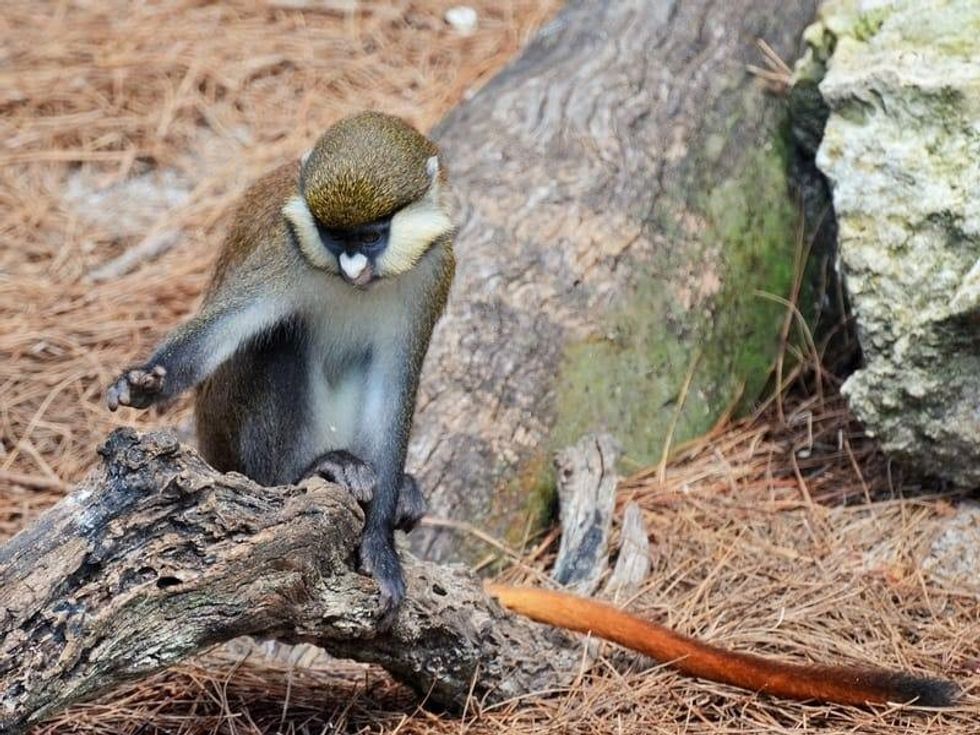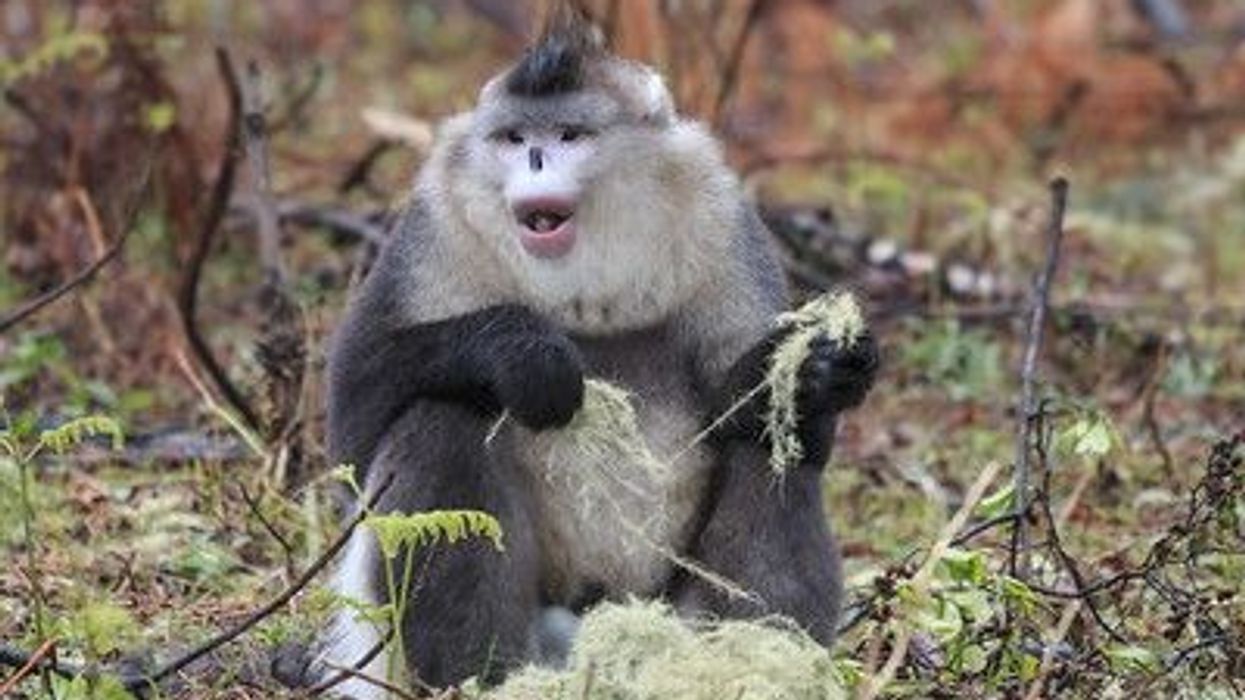The red-tailed monkey (Cercopithecus ascanius schmidti) is a species of primates found only in Angola, Uganda, the Central African Republic, Kenya, and the Democratic Republic of the Congo. They are also known as black-cheeked monkeys, white-nosed monkeys, red-tailed guenon, red-tail monkey, or Schmidt's guenon.
The main habitat for this species is swamp forest, rain forest, woodlands, riverine forest, and, gallery forest. Guenon are known to have more than one partner and females are usually part of groups with one male head or alpha males.
These monkeys are omnivores and eat leaves, flowers, insects, buds, and gum. The food is usually stored in their large cheek pouches and they can form a large group of seven to 30 monkeys.
Red-tailed monkey females give birth to only one offspring and together they can form all-male groups or survive alone after they leave their mothers. Guenon species are known for their peculiar appearance. They have a red colored long tail and a white nose.
Keep reading for more amazing facts about the red-tailed monkey! Also, check out other articles with interesting facts about Russian bear dogs and Asiatic lions.
Red-Tailed Monkey Interesting Facts
What type of animal is a red-tailed monkey?
The red-tailed monkey (Cercopithecus ascanius schmidti) is a species of monkey found in the forest habitat of East and Central Africa.
What class of animal does a red-tailed monkey belong to?
The red-tailed monkey belongs to the class of mammals of the Cercopithecus genus from the Cercopithecidae family and the order primates. For this white-nosed monkey, its red tail is one of its most distinguishing features.
How many red-tailed monkeys are there in the world?
There is no exact estimate of the red-tailed monkey population.
Where does a red-tailed monkey live?
Red-tailed monkeys live throughout the rainforests of Africa. This includes the forest of the Central African Republic, and parts of the Democratic Republic through to Kenya, Angola, and Zambia. The largest population of guenons can be found in the Ugandan forest.
What is a red-tailed monkey's habitat?
Schmidt's red-tailed monkeys of central Africa are very versatile in their habitat preferences. They can be spotted in tropical rainforests, swamp forests, woodlands, riverine and, gallery forests.
Who do red-tailed monkeys live with?
Most monkey species are social and tend to live with other monkeys. The red-tailed monkey is no stranger to this and can live in a male-dominated group of about seven to 30 individuals. Generally, there are males, females, and young ones in a group. The groups can be territorial and will protect their forest area if they feel threatened.
How long does a red-tailed monkey live?
The Schmidt's red-tailed monkey species has an average lifespan of about 25 to 30 years.
How do they reproduce?
Red-tailed monkeys are polygynous which means one dominant male will mate with multiple females in the group. There is no particular breeding season and a Schmidt's guenon male mates with females throughout the year.
Most females in the group will give birth to a single offspring. The gestation period can last from five to seven months. Male young ones reach maturity in six years, while females take four to five years.
What is their conservation status?
The Schmidt's red-tailed monkey is listed as Least Concern by the IUCN which means that their population is fairly stable and not in any immediate danger. Due to deforestation and hunting pressure, their numbers are showing signs of decreasing.
Red-Tailed Monkey Fun Facts
What do red-tailed monkeys look like?
Schmidt's red-tailed monkeys are generally known for their red tail. Males are generally larger than females and live in a group.
This black-cheeked, white-nosed monkey has large cheek pouches in which they can carry food. They may have blueish skin around their eyes. Their coat can be spotted with brown, black, or gray limbs, depending on the subspecies of the monkey.
How cute are they?
These monkeys have quite a charming appearance which makes them look very cute. If you look closely, Schmidt's red-tailed monkey nose has a small heart on it. They also have a beautiful red shaded tail which makes them very cute.
How do they communicate?
The red-tailed monkey species can communicate through body language and facial cues like raising their eyebrows and bobbing their head. They also use shrill chirps to alert other monkeys in case an intruder is seen in their territory. They may also use chemicals or nose rubbing to communicate.
How big is a red-tailed monkey?
Schmidt's red-tailed monkeys are 12-24 in (30-70 cm) in height and can be up to four times the size of a pygmy squirrel.
How fast can a red-tailed monkey move?
There is no research on the speed of a red-tailed monkey.
How much does a red-tailed monkey weigh?
The average weight of this species is 6-10 lb (2.7-4.5 kg).
What are the male and female names of the species?
There are no names for male and female red-tailed monkeys. Groups of these monkeys can be called a troop, a barrel, a cartload, and a tribe.
What would you call a baby red-tailed monkey?
There is no particular name for a baby red-tailed monkey.
What do they eat?
Red-tailed monkeys are omnivores and they mainly feed on flowers, leaves, seeds, insects, buds, and fruits. They are known to carry food in their cheek pouches to avoid any other monkey trying to steal. Guenons usually look for food in the early morning and late evening. Main predators include humans, chimpanzees, crowned hawk eagles, and leopards.
Are they poisonous?
The Schmidt's red-tailed monkey is not poisonous and they are harmless to human beings. They tend to stay with other monkeys in the forest without much interference from humans. They may sometimes raid agricultural facilities and are also a carrier of yellow fever.
Would they make a good pet?
Red-tailed monkeys are a common species in Africa but they are best handled by people who have experience in raising monkeys. They would prefer a natural forest habitat which makes them quite exotic and expensive pets to own.
Did you know...
Red-tailed monkeys are known as seed dispersers and help trees like Strychnos mitis. They tend to carry fruits around and spit seeds onto the forest floor, allowing the tree population to remain stable.
How to take care of a red-tailed monkey?
Red-tailed monkeys are social animals and it is not good to keep them isolated. It is best to keep at least two to three monkeys together and feed them very frequently.
They need plenty of room to run around and exercise which means they will need an area with a lot of space and preferably some trees. They can get aggressive if their cage is too small.
Are they loud?
A Schmidt's red-tailed monkey can be very loud if it is protecting its territory against intruders and warning others in its group that there is a threat. Otherwise, they are a relatively calm species.
Here at Kidadl, we have carefully created lots of interesting family-friendly animal facts for everyone to discover! Learn more about some other mammals including gerenuk, and Bharal.
You can even occupy yourself at home by coloring in one of our free printable red-tailed monkey coloring pages.









